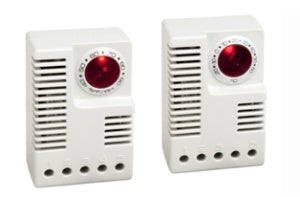
STEGO is proud to introduce its two newest products; the electronic thermostat ETL 011 and the electronic hygrostat EFL 012.
The electronic thermostat ETL 011 is suitable for the recognition of temperatures inside enclosures, while the electronic hygrostat EFL 012 detects the amount of humidity in an enclosure.
Both allow an indirect control of heaters, as well as filter fans or cooling devices by means of an integrated change-over contact, particularly developed and designed for switching signal voltages, and are tailored to be used in combination with the STEGO Switch Module SM010.
They can also be connected to other devices for signal processing, such as a programmable logic controller (PLC).
Supply voltage range
Both controllers are equipped with a universal power supply unit. This means that the controllers can be supplied with nominal voltages from DC 12V to 48V. As a result, one regulator is sufficient for all standard DC voltages (12V, 24V and 48V). An assessment as to which DC voltage is used in an application for signal processing is not necessary. A major advantage for clients is that they do not need to stock and maintain multiple controllers for different voltages.
Versions
The electronic thermostat ETL 011 is available in two versions, °C and °F. The electronic hygrostat EFL 012 is available in setting range 40% to 90% RH
Switching capacity
Since these controllers are not directly connected to a load (e.g. heater), it is not important that their switch contacts achieve a high switching capacity. Rather it is of importance that even very small signals can be switched. This is accomplished through a specific signal relay on the circuit board.
This relay can be used for very low currents and voltages: min. switching capacity: DC 10mW. But also currents of up to ½ amps are switched reliably.
Advantages in comparison to mechanical controllers
Compared to these new controllers, mechanical thermostats and hygrostats are generally not ideal for switching small DC signal currents. Unlike a relay, for example, that is protected by an enclosed housing the contact surfaces of the switch contacts of mechanical controllers are open. The potential danger of open contacts is that an oxide layer can build up on the open contact. The oxide layer is dielectric and stops the current flow after a certain time. The oxide layer is not degraded by the low energy content of DC signal currents.
For more information, please contact STEGO.
